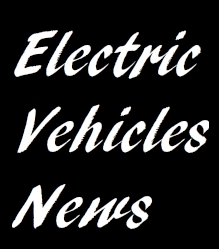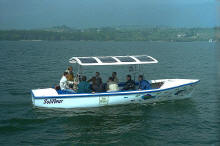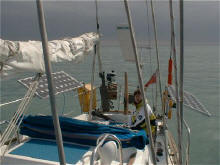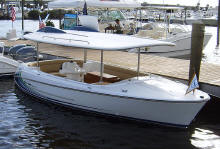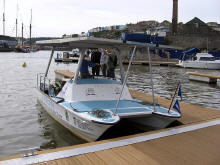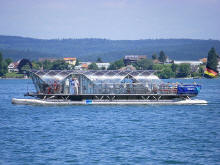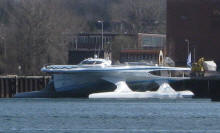Electric Boats
Featured Boats
|
While most boats on the water today are powered by diesel engines, and sail power and gasoline engines are also popular, it is perfectly feasible to power boats by electricity too. Electric boats were very popular from the 1880s until the 1920s, when the internal combustion engine took dominance. Since the energy crises of the 1970s, interest in this quiet and potentially renewable marine energy source has been increasing steadily again, especially as solar cells became available, for the first time making possible motorboats with an infinite range like sailboats. The first practical solar boat was probably constructed in 1975 in England. History Possibly the first electric boat was developed by Moritz von Jacobi in 1839 in St Petersburg, Russia - a 24' boat which carried 14 passengers at 3 mph. But it took more than 30 years of battery and motor development before they began to be deployed in any numbers. In 1886 an electric boat crossed the English Channel both ways in 8 hours. By 1889 the first 6 electric charter boats were working on the Thames and in the 1893 Chicago World Fair 55 electric boats carried more than a million passengers. Electric boats had an early period of popularity between around 1890 and 1910, before the emergence of the internal combustion engine drove them out. For example, an 1893 pleasure map of the Thames shows 8 "charging stations for electric launches" between Kew (Strand-on-the-Green) and Reading (Caversham).. Most of these were small passenger boats on non-tidal waters at a time when the only power alternative was steam. One of the largest in Britain, and the only surviving example, is the Mary Gordon which was built on the Thames for Leeds City Council for use on the Roundhay Park Lake. It was 52 foot long and could take 75 passengers and is now being restored. In the US, the Electric Boat Company was founded in 1899 and built the first submarine purchased by the U.S. Navy in 1900. Since then, electric power has been used almost exclusively for powering submarines underwater, although diesel was used for powering them on the surface until the development of diesel-electric transmission by the US Navy in 1928. The Electric Boat Company eventually became General Dynamics Corporation in 1952. The use of combined fuel and electric propulsion has gradually been extended over the years to the extent that some modern liners such as the Queen Mary 2 use only electric motors, powered by diesel and gas turbine engines. The advantages include being able to run the fuel engines at an optimal speed at all times and being able to mount the electric motor in a pod which may be rotated by 360° for increased maneuverability. The use of electricity alone to power boats stagnated apart from their outboard use as trolling motors until the Californian firm of Duffy started producing small electric craft in 1968. It wasn't until the 1980s that the Electric Boat Association was formed and solar powered boats started to emerge. ComponentsThe main components of the drive system of any electrically powered boat are similar in all cases, and similar to the options available for any electric vehicle. ChargerElectric energy has to be obtained for the battery bank from some source. Mains charger allows the boat to be charged from shore-side power when available. Shore-based power stations are subject to much stricter environmental controls than the average marine diesel or outboard motor. By purchasing green electricity it is possible to operate electric boats using sustainable or renewable energy. Solar panels can be built into the boat in reasonable areas in the deck, cabin roof or as awnings. Some solar panels, or photovoltaic arrays, can be flexible enough to fit to slightly curved surfaces and can be ordered in unusual shapes and sizes. Nonetheless, the heavier, rigid mono-crystalline types are more efficient in terms of energy output per square meter. The efficiency of solar panels rapidly decreases when they are not pointed directly at the sun, so some way of tilting the arrays while under way is very advantageous. Towed generators are common on long-distance cruising yachts and can generate a lot of power when traveling under sail. If an electric boat has sails as well, and will be used in deep water (deeper than about 15 m or 50 ft), then a towed generator can help build up battery charge while sailing (there is no point in trailing such a generator while under electric propulsion as the extra drag from the generator would waste more electricity than it generates). Some electric power systems use the free-wheeling drive propeller to generate charge through the drive motor when sailing, but this system, including the design of the propeller and any gearing, cannot be optimized for both functions. It may be better locked off or feathered while the towed generator's more efficient turbine gathers energy. Wind turbines are common on cruising yachts and can be very well suited to electric boats. There are safety considerations regarding the spinning blades, especially in a strong wind. It is important that the boat is big enough that the turbine can be mounted out of the way of all passengers and crew under all circumstances, including when alongside and when coming alongside a dock, a bank or a pier. It is also important that the boat is big enough and stable enough that the top hamper created by the turbine on its pole or mast does not compromise its stability in a strong wind or gale. Large enough wind generators could produce a completely wind-powered electric boat. No such boats are yet known although a few mechanical wind turbine powered boats exist.
In all cases, a charge regulator is needed. This ensures that the batteries are charged at the maximum rate that they safely can stand when the power is available. It also ensures that they are not overcharged when nearing full charge and not overheated when a large charge current becomes available. Battery bankThere have been significant technical advances in battery technology in recent years, and more are to be expected in the future.
The size of the battery bank determines the range of the boat under electric power alone. The speed that the boat is motored at also affects this - a lower speed can make a big difference to the energy required to move a hull. Other factors that affect range include sea-state, winds and any charge that can be reclaimed while under way, for example by solar panels in full sun. A wind turbine in a good following wind will help, and motor-sailing in any wind could do so even more.
Speed controllerTo make the boat usable and maneuverable, a simple-to-operate forward/stop/backwards speed controller is needed. This must be efficient—i.e. it must not get hot and waste energy at any speed—and it must be able to stand the full current that could conceivably flow under any full-load condition. One of the most common types of speed controllers uses Pulse-width modulation (PWM). PWM controllers send high frequency pulses of power to the motor(s). As more power is needed the pulses become longer in duration. Electric motorA wide variety of electric motor technologies are in use. Traditional field-wound DC motors were and still are used. Today many boats use lightweight permanent magnet DC motors. The advantage of both types is that while the speed can be controlled electronically, this is not a requirement. Some boats use AC motors or permanent magnet brushless motors. The advantages of these are the lack of commutators which can wear out or fail and the often lower currents allowing thinner cables; the disadvantages are the total reliance on the required electronic controllers and the usually high voltages which require a high standard of insulation. Drive trainTraditional boats use an inboard motor powering a propeller though a propeller shaft complete with bearings and seals. Often a gear reduction is incorporated in order to be able to use a larger more efficient propeller. This can be a traditional gear box, coaxial planetary gears or a transmission with belts or chains. Because of the inevitable loss associated with gearing, many drives eliminate it by using slow high-torque motors. The electric motor can be encapsulated into a pod with the propeller and fixed outside the hull (sail-drive) or on an outboard fixture (outboard motor). TypesThere are as many types of electric boat as there are boats with any other method of propulsion, but some types are significant for various reasons.
Pollution and embodied energyAll the component parts of any boat have to be manufactured and will eventually have to be disposed of. Some pollution and use of other energy sources are inevitable during these stages of the boat's life and electric boats are no exception. The benefits to the global environment that are achieved by the use of electric propulsion are manifested during the working life of the boat, which can be many years. These benefits are also most directly felt in the sensitive and very beautiful environments in which such a boat is used. The May 2010 edition of Classic Boat magazine carried a pro and con article entitled Electric debate. Jamie Campbell argued against electric boating on four main counts, which were rebuffed by Kevin Desmond and Jamie Campbell, Vice Chairman, Electric Boat Association. He asserted that electric propulsion can no more be justified afloat than a Seagull outboard motor, proposing wooden sailing boats and rowing dinghies as "by far the most environmentally sensitive and renewable options for recreational boating".
The article mentions 25% and 30% discounts being offered to electric boaters by the UK Environment Agency and the Broads Authority and that battery powered vehicles have 3⁄5 the carbon footprint of their petrol equivalents. It is claimed that a typical recharge after a day's cruising costs £1.50, without the use of solar or wind power. Solar shipsJapan's biggest shipping line Nippon Yusen KK and Nippon Oil Corporation said solar panels capable of generating 40 kilowatts of electricity would be placed on top of a 60,000 ton car carrier ship to be used by Toyota Motor Corporation. In 2010, the Tûranor PlanetSolar, a 30 meter long, 15.2 meter wide catamaran yacht powered by 470 square meters of solar panels, was unveiled. It is set to circumnavigate the Earth and is so far the largest solar-powered boat ever built.
Some information extracted from Wikipedia, the free encyclopedia: Text is available under the Creative Commons Attribution-ShareAlike License; additional terms may apply. See Terms of Use for details. |
